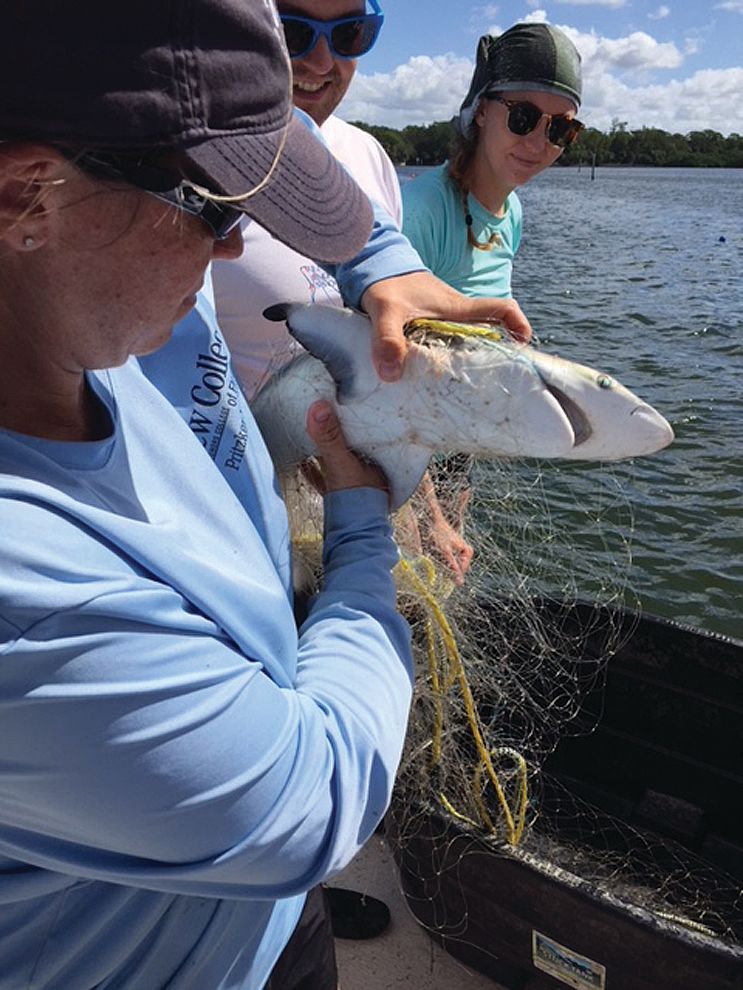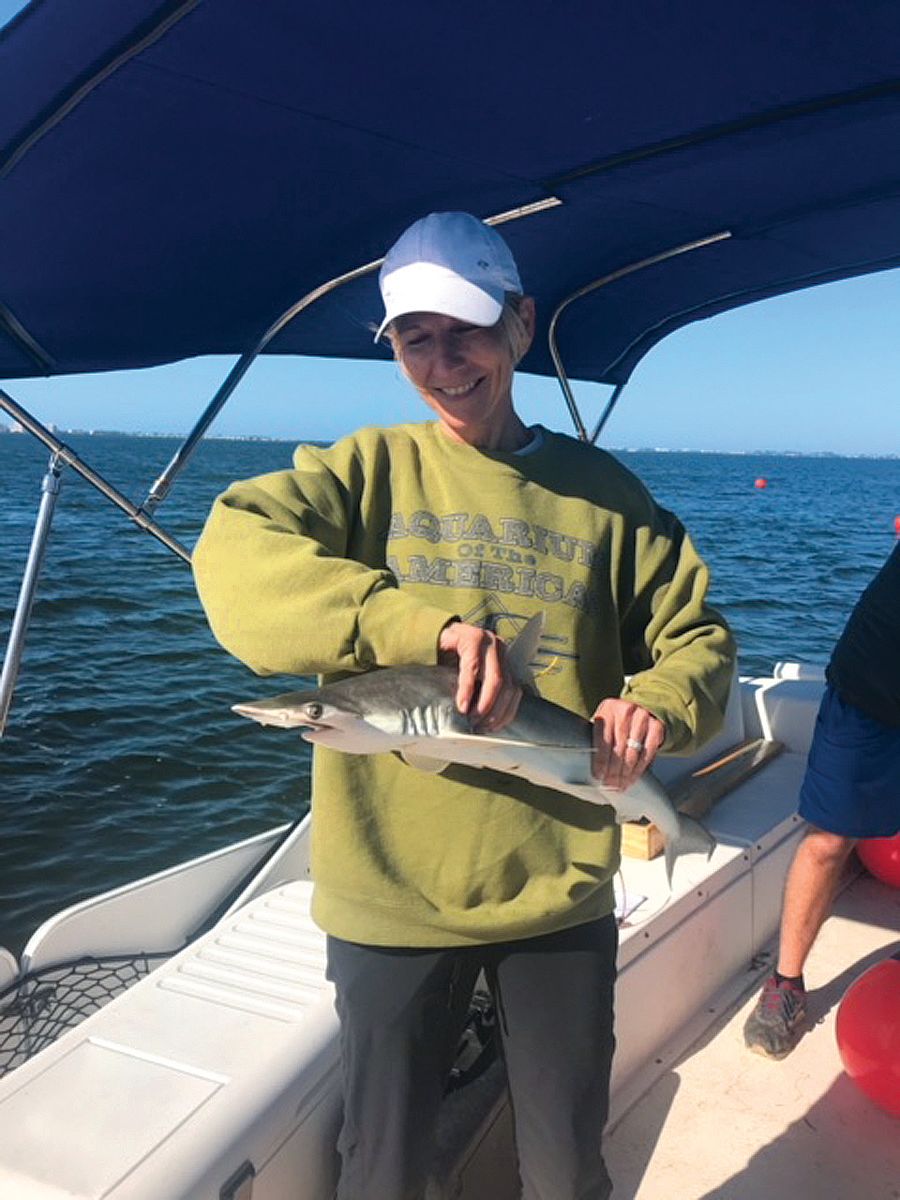I Tried It: Tagging Sharks in Sarasota Bay

New College professor Jayne Gardiner pulling a blacktip shark from Sarasota Bay.
Years ago, a surfer friend was about to take my 8-year-old daughter out for a paddle. “Are there sharks?” she asked.
“Put your index finger in the water and then taste it,” he said. “If it’s salty, there are sharks.”
He was right. Sharks live in every ocean on earth, and some—like the bull shark—also like fresh water. But Jayne Gardiner, assistant professor of biology at New College of Florida, is taking a more scientific approach to finding sharks than the finger-licking technique. For two years, she’s been conducting the first-ever survey of shark activity in Sarasota Bay. Her research is part of Gulfspan, a NOAA project that is studying juvenile sharks in coastal areas of the Gulf of Mexico.
Shark-a-phobes may wish that sharks weren’t anywhere near the Gulf or bay. But their presence is important. Economically, they bring recreational and commercial fishers to the region. More crucially, sharks are apex predators, essential to the food chain. “If we’re not managing our marine system, everything goes off balance,” says Gardiner. Many shark species have been declining in number, mainly due to overfishing, but also because of habitat destruction and climate change. Discovering whether young sharks can thrive in Sarasota Bay allows researchers to assess and further protect the bay’s health.
As the sun begins to rise on a chilly October morning, Gardiner, New College coordinator of research projects Joel Beaver, and their team of three students and two recent New College graduates pull up to the 10th Street boat ramp. It’s one of those perfect, cloudless, quiet mornings when being a marine biologist seems like the best job in the world. And perhaps it is. Last year, Gardiner was so reluctant to leave the water that she tagged sharks until two weeks before she gave birth to her son.
This trip is one of the last runs of the season. Many local species of sharks give birth in the spring and by the end of October, their pups are old enough and big enough to swim south in search of warmer waters. So far this season, Gardiner has tagged a little more than 100 sharks. It’s far fewer than the 200 she tagged in 2016. “The long red tide bloom last year may have affected 2017,” she says.
But the two seasons of tagging have been rewarding. Gardiner has been able to catch five shark species (bonnetheads, blacknoses, blacktips, Atlantic sharpnoses and scalloped hammerheads). “We’re finding pregnant females, young sharks and newborns,” she says. “This could make us a nursery.” This trip, she’s hoping to find a young blacktip, her research specialty. “I was led to believe there weren’t any blacktips in Sarasota Bay, so it’s been exciting to find them,” she says.
Gardiner and crew board the RV Limbatuf (Latin name for blacktip), a 24-foot pontoon boat, and lug a 75-gallon bucket filled with a 180-meter gill net (they have a permit) and neon orange buoys and set off. The first stop is just off Long Bar Pointe, the beautiful coastline of untouched mangroves along the mainland that is destined to become the residential-retail development Aqua by the Bay. The students drop the net, which is anchored by lead weights at the bottom and marked by orange buoys at the top, and motor away, letting the net stretch across the bay.
In a few minutes, one of the corks attached to the top of the net dips underwater and the team knows they’ve snagged something. The boat putters back to the bobbing cork and the students hook the net and pull out two wriggling mature male bonnethead sharks about two feet long.

The author holding a bonnethead shark
Bonnetheads, the second-smallest member of the hammerhead family, are soft, like suede, and cute, if that can be said about a shark. They don’t get any bigger than four feet or weigh much more than 24 pounds. The students are old hands at handling the sharks. They measure their length and get ready to tag them.
The tagging needle, about the width of a pencil, has a barb at the tip. Inside is a skinny four-inch yellow dart with an I.D. number and a NOAA phone number to call in case anyone catches this shark again. (If you call, you get a reward.) Students jab the shark in the muscle below the first dorsal fin, give a little quarter twist and pull the instrument out, leaving the tag, like a tiny flagpole, behind. Then a student picks up the shark with two hands, leans over the side of the boat and places it back in the water. The whole process takes only a minute.
The boat makes three more stops, pulling up three more adult bonnetheads, along with Spanish mackerel, catfish, croakers, pinfish, permit, pompano, bluefish, cowfish and a ray. Everything is measured and returned to the water.
Four hours later, the Limbatuf stops at its fifth and final destination just north of Crosley Estate in Manatee County. The team drops the net and waits. And waits. Nothing. Beaver plays some classic rock from his wireless speaker—“blacktips like it,” he jokes—and everyone laughs. The crew begins to pull the net in, and there it is. A blacktip, about 6 months old and 2½ feet long. Gardiner is thrilled. Since the blacktip is the only fish in the net, there’s time to implant an acoustic device that will ping for 10 years, so that any time the shark gets near a listening station in the bay or one of the passes, Gardiner will know.
She lays the shark on its back on an ingenious surgery table—a flower box with thick egg crate foam padding that Beaver calls a shark taco holder—and places a tube in its mouth to keep sea water pumping through its gills. Gardiner makes a small incision in its belly, inserts the acoustic tag and sutures the wound. Then she slides the blacktip back into the water, where it immediately dives under.
The crew is in high spirits as the boat heads back toward the dock. It was a good day for shark tagging.
